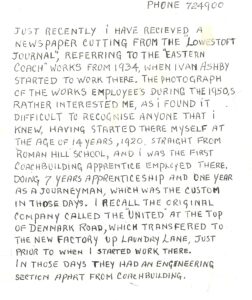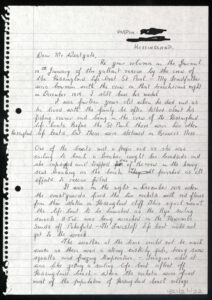SD Art of Communication & Westgate on Friday
28 April 2022
Introduction to the Art of Communication & Westgate
on Friday
This issue of the Special Delivery News presents a week-by-week account of the creative sessions run by poet Dean Parkin and visual artist Kate Munro, as they explored the art of communication with pupils at Roman Hill Primary School and Britten Court Care Home residents.
Inspired by collections of letters held by Suffolk Archives and in county museums, Special Delivery brings together primary school
pupils and residents in care homes to consider different ways of
communicating—and invent a few of their own.
Westgate on Fridays
For the Britten Court Care Home and Roman Hill Primary School programme, our visual artist Kate and local poet Dean chose two letters sent to the journalist Trevor Westgate.
Full of stories of local events and characters, these letters were used by Trevor to create a regular column in the Lowestoft Journal.
Dean and Kate chose two letters, and they could not have been more different.
The first was written by Albert, who left Roman Hill Primary School in 1920, aged 14, to become an apprentice coachbuilder.
Both artists were struck by the style in which the letter was written; Albert used capital letters throughout his letter, except when he referred to himself.
The second letter, written by Gordon, reads like an adventure story—and it’s a true story, all about the Kessingland lifeboat, the St Paul, and the bravery of the crew on a stormy night in December 1919.


First letter:
Phone 724900
Just recently I have recieved a newspaper cutting from the “Lowestoft Journal” referring to the “Eastern Coach” works from 1934, when Ivan Ashby started to work there. The photograph of the works employees during the 1950’s rather interested me, as I found it difficult to recognise anyone that I knew, having started there myself at the age of 14 years, 1920, straight from Roman Hill School, and I was the first coachbuilding apprentice employed there, doing 7 years apprenticeship and one year as a journeyman, which was the custom in those days. I recall the original comapany called the “United” at the top of Denmark Road, which transfered to the new factory up Laundry Lane, just prior to when I started work there. In those days they had an engineering section apart from coachbuilding.
Second letter:
Gordon —– Kessingland
Dear Mr Westgate,
Re your column in the Journal 10th January of the gallant rescue by the crew of the Kessingland lafe-boat St Paul. My grandfather was bowman with the crew on that trecherous night in December 1919. I still have his medal.
I was fourteen years old when he died and as he lived with the family he often talked about his fishing career and being on the crew of the Kessingland life-boats. Before the St Paul there were two other Kessingland life boats, bbut these were stationed on Benacre Ness.
One of the boats met a tragic end as she was sailing to beach, a breaker caught her broadside and she capsized and trapped one of the crew in the heavy seas breaking on the beach, perished as all efforts to rescue failed.
It was on the night in December 1919 when the coastguards fired the two rockets with red flares from their station on Kessingland Cliff. This signal meant the life-boat to be launched as the Rye sailing smack AJW. was being wrecked on the Newcombe Sands off Pakefield. The Lowestoft life boat could not get to the wreck.
The weather at the time could not be much worse as there was a strong easterly gale, heavy snow squalls and freezing temperature. Imagine what it was like getting a sailing life-boat afloat off Kessingland beach. When the rockets were fired most of the population of Kessingland beach village
1301/2/1/22
Keep up to date
Subscribe to our newsletter and receive information about our latest work and forthcoming events.
By subscribing to our newsletter you agree to the terms laid out by our privacy policy